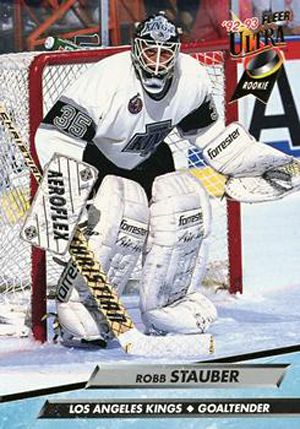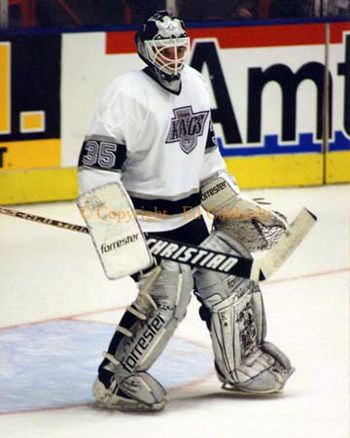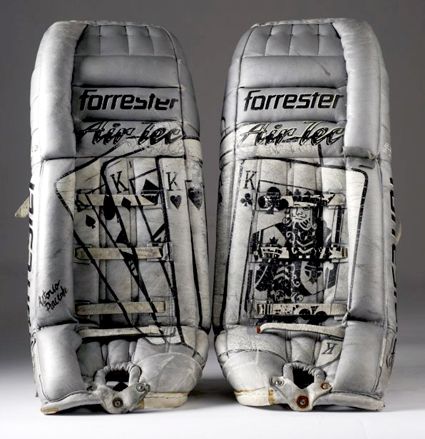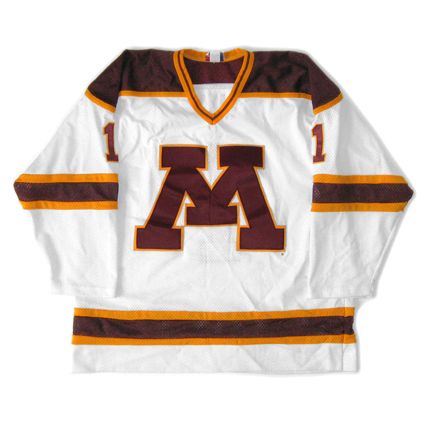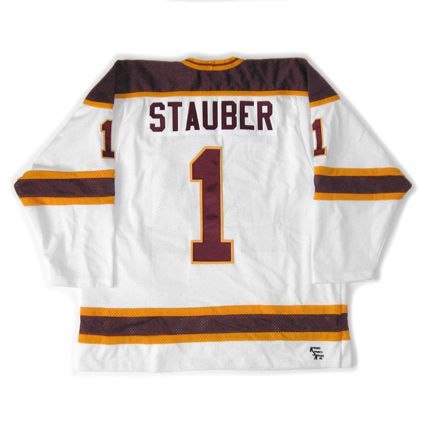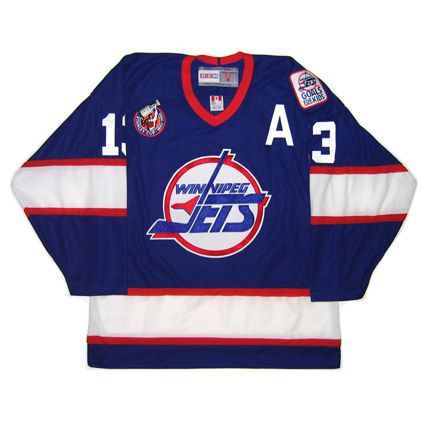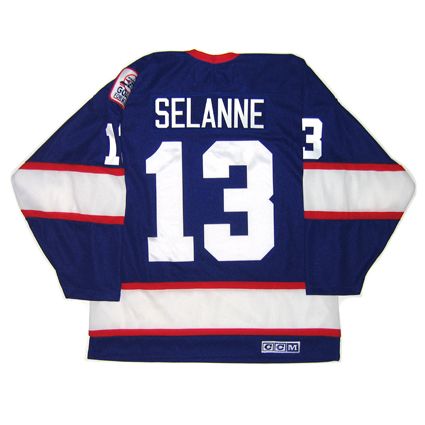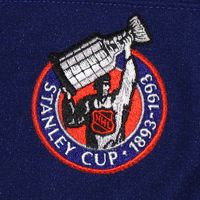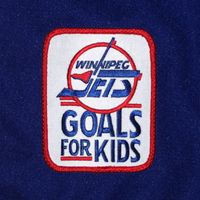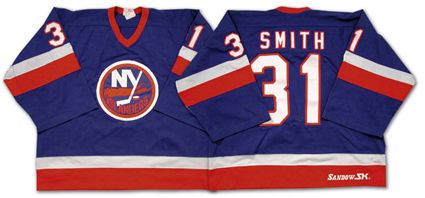
Saturday, November 28, 2009
1980-81 New York Islanders Billy Smith Jersey
NHL history was made on this date in 1979, when Rob Ramage of the hapless Colorado Rockies, while on a delayed penalty call, would send the puck back to the point anticipating a Rockies teammate would be stationed there, only to find the point vacated and the puck making the long journey down the length of the ice and right into the Rockies goal and the record books.

Since Islanders goaltender Billy Smith was the last Islander to touch the puck, he was the official scorer of the goal, the first one credited to a goaltender in NHL history.
Ron Hextall became the first goaltender to legitimately aim for the net and score a goal in the NHL on December 8, 1987 when he scored against the Boston Bruins, who had pulled goaltender Rejean Lemelin for a sixth attacker who was apparently not in any way a sixth defender.
Hextall scored a second goal during the playoffs on April 11, 1989 versus the Washington Capitals, entering the record books as the first goalie to score during the playoffs.
Chris Osgood of the Detroit Red Wings added his name to the list of goaltenders who have scored on March 6, 1996 with a shot the length of the ice in Hartford versus the Whalers.
April 17, 1997 would see the first of Martin Brodeur's pair of goals, as he would fire one in against the Montreal Canadiens. Brodeur would be credited with his second goal, despite being about 125 feet from the puck when a mishandled puck by a Philadelphia Flyer at his own blueline found it's way into the unguarded Flyers net on February 15th of 2000.
Jose Theodore, then of the Montreal Canadiens would score with style on January 2, 2001 with a backhand shot, as he launched the puck the length of the ice on Long Island against New York in the process of shutting out the Islanders, the only goalie to shoot the puck into the goal and record a shutout in the same game.
Evgeni Nabokov joined the scoring ranks on March 10, 200o when he fired one in against the Vancouver Canucks in Vancouver for the sixth and most recent goalie to purposely shoot the puck into the opposing goal.
Damian Rhodes of the Ottawa Senators, Mika Noronen of the Buffalo Sabres and Chris Mason of the Nashville Predators would all receive credit for goals of the Billy Smith variety, as the opponents would all misfire in some manner and send pucks down the ice and into their own nets.
Today's featured jersey is a Sandow SK 1980-81 New York Islanders Billy Smith jersey, the same style he was wearing when he "opened the floodgates" of goalies scoring in the NHL.
In addition to going into the history books as the first goalie to score a goal, Smith did manage to accumulate four Stanley Cups during the early 1980's while with the New York Islanders dynasty.
This particular style of jersey with the white and orange sleeve stripes was first introduced for the 1978-79 and used through the 1983-84 season before the Islander changed the specification of the names on the back from two-color to single color white names.

Here is the play on which Billy Smith was credited with the first goal ever scored by an NHL goalie.
Here is a wonderful compilation of all the goals scored by goalkeepers in the NHL, several of which are direct shots by the goalies themselves, and not "own goals" on the part of the other team.
The last video today is a look at the career of Billy Smith from the "Greatest Hockey Legends" series.
Labels:
New York Islanders,
Smith Billy
Friday, November 27, 2009
1970-71 Detroit Red Wings Gordie Howe Jersey
On this date in 1960, Gordie Howe became the first player in NHL history to score 1,000 career points. Five years to the day later, Howe scored his 600th NHL goal on this day in 1965.
Mr. Hockey® made his NHL debut in 1946, wearing #17 and changed to his iconic #9 at the start of the following season for the purpose of a more preferable sleeping berth on the train while the team was traveling, as the accommodations were more spacious in the lower berths and were allocated based on each players sweater number.
One of the most dominate players in NHL history, Howe would finish in the top five in league scoring for twenty straight seasons.
Teamed with linemates Sid Abel and Ted Lindsay, "The Production Line" would dominate the NHL and lead Detroit to first place in the regular season standings for each of the four seasons they played together from 1948-49 to 1951-52, a span that would include a pair Stanley Cup Championships in 1950 and 1952. So dominant was the line that they finished first, second and third in league scoring in 1949-50, led by Lindsay's 78 points in 69 games.
Howe would not be around to lift the Stanley Cup in 1950, having suffered a fractured skull earlier in the playoffs, which required emergency surgery to relieve the pressure.
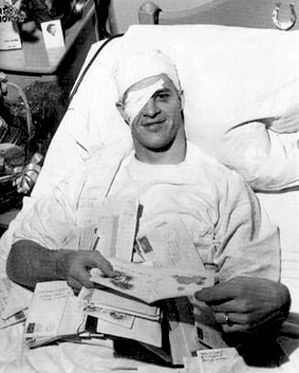
Howe would return to form the following season of 1950-51, scoring 86 points to win the scoring title by 20 points over his nearest competition, the first of seven times he would win the Art Ross Trophy.
Howe would continue throughout the 1950's to accumulate championships and awards, winning the Stanley Cup in 1950, 1952, 1954 and 1955, the Art Ross Trophy as scoring champion from 1951-1954 and 1957, and the Hart Memorial Trophy as the league MVP in 1952, 1953, 1957, 1958 and 1960.

It was on this date in 1960 that Howe registered an assist in a 2-0 win over the Toronto Maple Leafs to score his 1,000th NHL point, the first player in the 44 year history of the league to reach that milestone and he did it in his 938th game. It would be another eight years before Jean Beliveau would become the second and another 20 years before Howe would score his final point! Remember, Howe already had 14 years in the league behind him at this point.

1963 would see Howe capture both the Art Ross and Hart Trophies once more and on this date in 1965 Howe would score his 600th NHL goal in a game versus the Montreal Canadiens, becoming the first player in NHL history to record 600 goals. It would be until 1972 until Bobby Hull would become the second to 600.
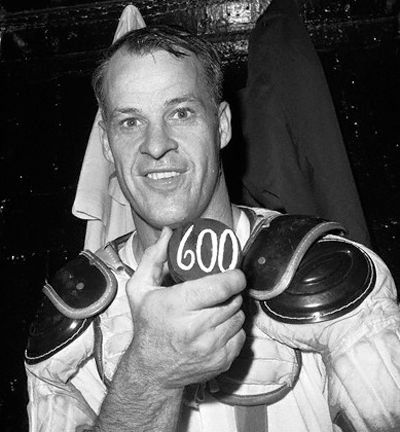
For comparison, Maurice Richard's final career totals when he retired in 1960 were 544 goals and 965 career points and he surprisingly never led the league in point scoring.
In 1968-69, aided by the recent NHL expansion to 12 teams which created a longer schedule of games against some admittedly weaker opponents, Howe achieved his one and only 100 point NHL season with 44 goals and 58 assists for 103 points.
Today's featured jersey is a 1970-71 Detroit Red Wings Gordie Howe jersey. 1970-71 would be Howe's final season with the Red Wings.
This jersey was auctioned off in March of 2006 for $3,536.34 with the description stating that Gordie "could have worn it."
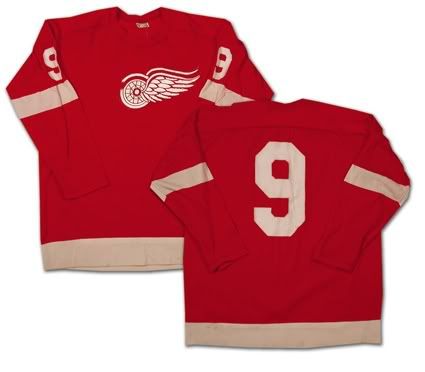
Today's video is the "Legends of Hockey" profile of Gordie Howe.
Here is an unusual find, Gordie Howe on the TV game show, "What's My Line?" being questioned by Hogan's Heroes' Colonel Klink Werner Klemperer and Soupy Sales. Howe's legendary toughness is apparent, as he is unfazed at being interrogated by a Nazi prison camp commandant.
Gordie tells Keith Olberman how hockey used to be and to respect your elders.
We had no idea overtime was ever a set period of time and not "sudden death" like we have only ever known.
Labels:
Detroit Red Wings,
Howe Gordie
Thursday, November 26, 2009
The Greatest Shootout Goal Ever
Black Friday Shopping News: As we enter the holiday season please take a moment to visit the Third Sting Goalie Online Store. There you will find a wide variety of shirts, sweatshirts, hoodies, caps, kids clothing and a few assorted items such as mugs and mousepads.
It's produced by Cafe Press, whom we have dealt with for some time now, and they produce very nice, quality goods, all featuring our patron saint Georges Vezina. Just simply click on the image below to visit the store.
We also wanted to take a moment and talk about the two groups of ads in the right hand column of our blog and let you know that these members of the "Third String Goalie Marketplace" are all chosen to be on our website by us at Third String Goalie and are almost universally companies we have dealt with directly and have had positive experiences with, unlike the previous "text ads" you may have seen here prior to September, which were chosen by Google based on keywords commonly appearing in this blog, and were sometimes irrelevant to what we do here or often ads for overseas manufacturers of knockoff merchandise - hockey jerseys in particular - which we were less than comfortable having on this blog and will no longer be running on this site.
The ads have recently been updated and are worth clicking on for jerseys, apparel, caps, tickets and gear, all things we have chosen to feature because we felt they would be of interest to you, our readers. Please take a moment to check them out and support those who support us.
Dasherboard: Since today is Thanksgiving in America, I'm anticipating traffic on The Internets will be down significantly as hockey fans are forced to travel to Aunt May and Uncle Ben's house, who don't even own a computer, and if they did for some unexpected reason actually have a hand-me-down PC given to them several years ago by Ben's nephew Peter, it would probably sound something like this.
So, since most of you will be forced to watch football, first featuring the horrid Detroit Lions followed by the equally abysmal Oakland Raiders, all while fighting off the effects of tryptophan, we are going to break from the usual format and try to give you something to stay awake for - The Greatest Shootout Goal of All-Time, which occurred on this very date back in 2005.
After a first period goal by Jason Ward, shorthanded and unassisted no less, followed by a goal just 14 seconds in to the second period by Jed Ortmeyer, the New York Rangers found themselves up 2-0 over the Washington Capitals.
At 3:32 of the second, Chris Clark pulled one back for the Capitals and Brian Willsie evened the score at 2-2 halfway through the game at 10:36.
Goaltenders Olaf Kolzig for Washington and Henrik Lundqvist kept the offenses off the board in the third, sending the game to overtime. The Rangers did manage six shots on Kolzig during the extra time and the Captials two, but neither team could get the game winner despite the Capitals starting the extra time on the power play.
As the game moved to the shootout, no one knew just how long it was going to take to decide the contest and certainly no one could have imagined the ending.
The teams matched misses, goals and misses through the standard three rounds which moved the shootout to the sudden death stage.
Rounds 4 and 5 were scoreless before Ville Nieminen and Chris Clark both scored in Round 6. Rounds 7 through 13 resulted in save after save after save. Finally in Round 14, Bryan Muir scored for the Capitals to put the pressure on Jason Strudwick of the Rangers, who beat Kolzig to send the shootout to the 15th Round.
After a miss by Washington, with only two healthy skaters left on the bench, Rangers Coach Tom Renney called on defenseman Marik Malik, who had yet to score a goal all season.
What took place next will go down in hockey history as one of the most unexpected moments ever.
"You have to have guts to do that move," said the Rangers Jaromir Jagr. "In front of 20,000 people watching you, it's not that easy to do."
"I was watching everything before me," said Malik. "Olie was unbelieveable. He stopped everything from shots, moves. I just thought to myself, 'Maybe I'll surprise him.' I tried the move and it worked."
"It was actually kind of fun," Kolzig said. "On this stage, Madison Square Garden, Saturday night. I didn't expect Malik to pull a move off like that."
"I started to think it would never end," said Lundqvist.
But what an ending it turned out to be. Almost as good as the goal itself was Malik's "Piece of cake, I do this all the time" reaction afterwards.
For further viewing, and hopefully keeping you from having to watch any of the Lions game, the Top 15 NHL Shootout Goals of All-Time.
And in the interests of equal time and a reason to hopefully not have to see the Raiders game, something to be really thankful for, the 10 Worst Shootout Moments.
Labels:
humor
Wednesday, November 25, 2009
1987-88 University of Minnesota Golden Gophers Robb Stauber Jersey
Born on this date in 1967 in Duluth, Minnesota, goaltender Robb Stauber would become the first goaltender to win the Hobey Baker Award as the outstanding player in US College Hockey in the eighth season of the award.
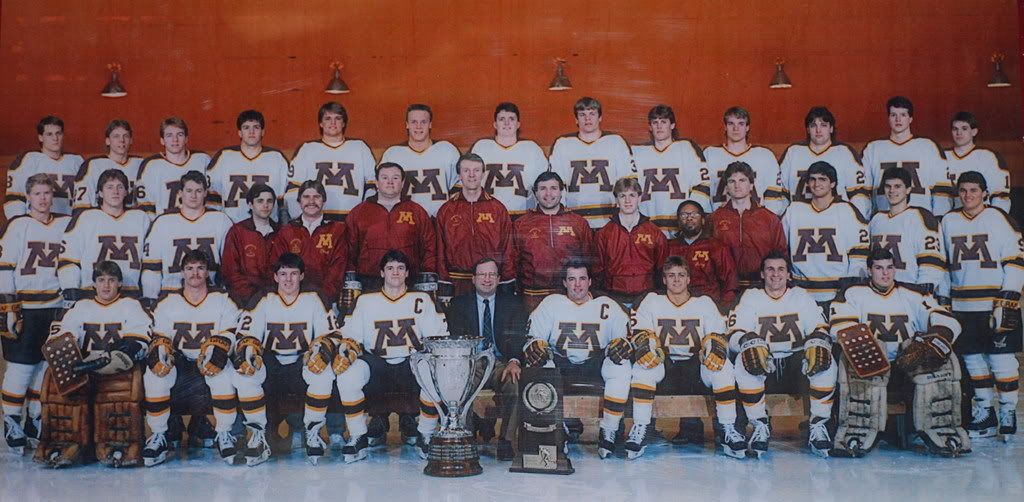


This jersey with it's classic hockey styling was first used by Minnesota in 1985-86 and the gold trim was added to the shoulder yoke after just one season. Today's featured jersey can be dated to precisely 1987-88 by the presence of the shoulder trim but the lack of a WCHA patch, which arrived in 1988-89 in gold. The WCHA patch changed to a more contrasting maroon color after one season and this style remained in use through 1992-93, the final season of the old Mariucci Arena. The only other variation of the jersey was in 1990-91 when a USA flag patch was worn (only on the home jerseys) following a wave a patriotism following the outbreak of the first Gulf War in August of 1990.
After being named an All-State Goalkeeper at Duluth Denfeld High School, Stauber would attend the University of Minnesota beginning in 1986. He would appear in 20 games and finish with a 13-5 record while splitting time with future Boston Bruins goalie John Blue. The Gophers would finish third in the nation that season after making it to the NCAA Final Four. Stauber would record his first point that season after being credited with an assist. During the season he would also play for the United States in the World Junior Tournament.
Stauber's second season with the Golden Gophers in 1987-88 would see him set a team record with 44 games played, posting a 34-10 record and lowering his goals against average from 3.53 down to 2.72 and help the team capture the WCHA Championship.

The Gophers would make another trip to the Final Four before losing to St. Lawrence 3-2 on a goal in the final minute of the game. Never one to sit back and watch the play develop, Stauber was always on the lookout to fire a long pass to send one of his potent forwards back up the ice in the other direction, and collected five assists as a result. At the end of the season he would be named the winner of the John Mariucci Award as the Gophers's Most Valuable Player, be named WCHA Goaltender of the Year, earn All-WCHA First Team honors, be named to the All-America first team, earning a coveted spot on one of the Mariucci Arena murals, reserved for Gopher First Team All-Americans, and become the first goaltender to win the Hobey Baker Award.

1988-89 would see the Gophers capture back to back WCHA Championships and Stauber would see action in 34 games, post a 26-8 record and lower his goals against average yet again to 2.43. His assist total would climb to seven, despite playing ten fewer games than the previous season. Stauber and the Gophers would make it all the way to the NCAA Championship game only to lose to Harvard 4-3 in overtime in one of the greatest college hockey games of all time. Stauber would be named the WCHA Goaltender of the Year for the second season in a row and be named one of the ten finalists for the Hobey Baker Award.
His final college career stats shows a 2.77 goals against average and a 73-23 record and he was recently named one of the Top 50 Players in WCHA History. Without question, Stauber was a supremely talented goaltender which gave him the confidence to often leave his crease to challenge shooters or corral the puck before attempting another of his home run passes to his forwards up the ice. In fact, he would even score a goal while playing in the minors later in his career.

Following his collegiate career, Stauber would make another appearance for the United States, this time at the 1989 World Championships in Stockholm, Sweden.
The next season, 1989-90, he would make his NHL debut for the Los Angeles Kings, seeing action in a pair of games as a teammate to Wayne Gretzky. He would spend the next two seasons in the minors and return to the NHL full time in the 1992-93 season, in which the Kings would make it all the way to the Stanley Cup Finals with Stauber seeing action in four games verus the Calgary Flames in the opening round.
After one more season in Los Angeles where Stauber would play in 22 regular season games, including wearing the first decorated goalie pads in NHL history.
Stauber was traded to the Buffalo Sabres during the 1994-95 season, seeing six games of action.
Stauber during the 1993-94 season (above) wearing
the first decorated goalie pads in NHL history (below)
Stauber was traded to the Buffalo Sabres during the 1994-95 season, seeing six games of action.
He would spend the next three seasons back in the AHL with Rochester, where he once scored a goal, Portland and Hartford.
His final NHL totals are 62 games played with 21 wins, 23 losses and 9 ties, 1 shutout and a 3.80 goals against average along with 4 playoff games and a 3-1 record.
Since retiring as a player, Stauber has opened Stauber's Goalcrease Academy to train goalkeepers, written a book about, what else, goaltending, and has been the goaltenders coach for the University of Minnesota.
Today's featured jersey is a 1987-88 University of Minnesota Robb Stauber jersey as worn during his career at the University of Minnesota, including his Hobey Baker winning season and was lettered by our friends at VintageMinnesotaHockey.com.
This jersey with it's classic hockey styling was first used by Minnesota in 1985-86 and the gold trim was added to the shoulder yoke after just one season. Today's featured jersey can be dated to precisely 1987-88 by the presence of the shoulder trim but the lack of a WCHA patch, which arrived in 1988-89 in gold. The WCHA patch changed to a more contrasting maroon color after one season and this style remained in use through 1992-93, the final season of the old Mariucci Arena. The only other variation of the jersey was in 1990-91 when a USA flag patch was worn (only on the home jerseys) following a wave a patriotism following the outbreak of the first Gulf War in August of 1990.
It's a true disappointment that Stauber's college career took place prior to the age of youtube, since he was simply the most spectacular, dynamic and aggressive goaltender we have ever had the privilege of watching play live. Luckily, we did find these highlights of a vintage Gopher playoff game that contains some classic rare footage showing Stauber playing with reckless abandon early in the video from 1988 in the original Mariucci Arena. Hopefully this will give you some hint of what kind of an amazing video a true compilation of Stauber's best saves and most daring challenges would have looked like.
"SAVE BY STAUBER!!"
Labels:
Stauber Robb,
University of Minnesota,
WCHA
Tuesday, November 24, 2009
1991-92 Chicago Blackhawks Chris Chelios Jersey
On this date in 2006, Chris Chelios passed Phil Housley as the all-time leader in games played by an American born player when he skated in his 1,496th game as his Detroit Red Wings hosted the St. Louis Blues at the Joe Louis Arena.
Chelios' career began in 1983 as a member of the Montreal Canadiens, who drafted him in the 1981 NHL Entry Draft, prior to the debut of MTV and six years before Sidney Crosby was born!
Other players drafted by the pick-rich Canadiens prior to selecting Chelios were Mark Hunter (628 NHL games played) 7th overall in the first round, Gilbert Delorme (541 GP) 18th in the first round, Jan Ingman (zero GP) 19th in the first round, and Lars Eriksson (zero GP) 32nd in the second round before picking Chelios 40th, the 16th defenseman chosen in the draft!
Chelios assault on the record was aided by his obvious durability, with 19 of Chelios 25 NHL seasons seeing him play in 65 games or more. In addition, he was on a number of successful teams, with deep playoff runs being a regular part of Chelios career. Nine times he would play an additional 14-24 postseason games for a total of 268 career playoff games plus 11 appearances for the United States in international competitions, often as team captain.
Chelios current career NHL total stands at 1,644 games played, 475 more than the four players Montreal drafted before him combined. While he is still actively playing, it is with the Chicago Wolves of the American Hockey League and his days in the NHL could be at an end, but his experience could still prove to be valuable and earn him the opportunity to add to his NHL total later in the schedule.
Chelios would play seven seasons in Montreal, including winning the Stanley Cup in 1986, before moving to the Chicago Blackhawks in exchange for Denis Savard. Nine seasons in Chicago would be highlighted by another return to the Stanley Cup Finals in 1992 before being traded to the rival Detroit Red Wings near the end of the 1998-99 season. Ten seasons in Detroit would earn Chelios another pair of Stanley Cups, in 2002 and again in 2008, with 2008 being a bit of a special case. Chelios would play in 14 playoff games that year, although none of them were in the final series versus Pittsburgh, but under league rules, he rightly earned having his named engraved on the cup for the third time.
During his career, Chelios was named the winner of the James Norris Trophy as the NHL's Best Defenseman in 1989, 1993 and 1996.
Other durable American players in the NHL after Housley (1,495 games played) have included;
#3 Mike Modano* (1,408), #4 Jeremy Roenick (1,363), #5 Mathieu Schneider* (1,272), #6 Craig Ludwig (1,256), #7 Bill Guerin* (1,207), #8 Brian Leetch (1,205), #9 Doug Weight* (1,195) and #10 Scott Young (1,181). Other still active players with a chance to move up include #15 Keith Tkachuk (1,152), #23 Brian Rolston (1,060) and #24 Todd Marchant (1,058).
* - active players
Today's featured jersey is a 1991-92 Chicago Blackhawks Chris Chelios jersey. This jersey is from the NHL's 75th Anniversary Season and was worn during the regular season with the NHL 75th Anniversary patch, but with the Blackhawks reaching the Stanley Cup Finals versus the Pittsburgh Penguins, the 75th Anniversary patch was covered up with the 1992 Stanley Cup Finals patch.
Here is an interview Chelios where he recaps his career and includes footage from the different teams he suited up for.
In this clip, the mentally insane Ron Hextall charges out of his net to attack Chelios for an earlier incident. Any enemy of Hextall is a friend of ours.
Finally, a clip we've been dying to run since the day we started this blog. In honor of our first follower in Twitter, Inglewood Jack, we proudly present Chris Chelios reminiscing about his favorite hockey coach, Jules Winnfield. Watch as Jules teaches his players the "Gourmet Shot" and of course, the "Inglewood Jack."
Labels:
Chelios,
Chicago Blackhawks
Monday, November 23, 2009
2008-09 Montreal Canadiens Saku Koivu 1945-46 Centennial Jersey
Born on this date in 1974, Saku Koivu of Finland was drafted by the Montreal Canadiens 21st overall in the 1993 NHL Entry Draft.
He began his career playing for TPS in his hometown of Turku, Finland. While he only scored 10 points during the regular season, he did score 5 points in 11 playoff games as TPS captured the SM-liiga playoff championship.
Progress was rapid for Koivu, as he would increase his point total to 53 in his second year and lead the league in scoring in his third with 73 points in 45 games and 17 more points in 13 games on his way to another playoff championship. He was named as the player's choice award for best player as well as regular season league MVP and playoff MVP.
Koivu would come to North America in 1995-96 to join the Canadiens. 45 points in 82 games his first year would be eclipsed in his second season with 56 points in only 50 games due to an injury. The remainder of Koivu's career would be dogged by injuries, as he currently has only five seasons of more than 70 games out of 13 seasons.
The litany of ailments seems endless. Knee injury, leg injuries, a dislocated shoulder, another knee injury, knee surgery, a public bout with lymphoma, more knee problems, a stick in the eye which resulted in a detached retina and a broken foot.
In 1999, Koivu was named captain of the Canadiens, the first European to hold that honor, and a position he would hold for the remaining nine seasons he would spend in Montreal. Despite the injuries, Koivu was a effective and respected captain and a consistently productive player when healthy.
After missing all but three games of the 2001-02 because of his lymphoma, Koivu would make an emotional comeback on April 9th and receive an eight-minute standing ovation. Following the final three games of the regular season, Koivu would score 10 points in 12 playoff games for Montreal, including eliminating top seeded and long-time rivals the Boston Bruins. Following the season he was named as the recipient of the Bill Masterton Trophy.
It was quite a statement that Koivu would then play in all 82 games of the Canadiens 2002-03 season and score 71 points in the process to lead the team by 21 points.
During the NHL lockout of 2004-05, Koivu would return home to play for TPS, who were coached by his father Jukka.
The 2006-07 season would see Koivu reach his 500th point at home on January 9, 2007. He would play 81 games that season, which would allow him to total 22 goals and 53 assists for a career-high 75 points in his 11th season, when many players careers are on the decline. In addition, he would be named that season's winner of the King Clancy Trophy.
Koivu would reach the 600-point plateau in October of 2008 and tie Jean Beliveau as the longest serving captain in team history at the conclusion of his 10th season as captain.
For the 2009-10 season, Koivu passed on the opportunity to play with his younger brother Mikko on the Minnesota Wild and instead opted to join fellow Finn Teemu Selanne on the Anaheim Ducks.
Internationally, Saku Koivu has been a long time and vital member of the Finnish National Team, competing for Finland on numerous occasions and being named team captain starting with the 1998 Winter Olympics.
He got his start for Finland at the 1993 World Junior Championships and later the World Championships that same year. He repeated the double in 1994, participating in both the World Juniors and World Championships, earning a silver medal at the Worlds. Further appearances in the World Championships came in 1995 (capturing gold), 1997, 1999 (silver), 2003 and 2008 (bronze) while being named Best Forward in 1995 and 1999, when he was the leading scorer.
Koivu would also skate for Finland in both the 1996 and 2004 World Cup of Hockey, earning a silver in 2004, as well as the Olympics earning a bronze medals in both 1994 and 1998 and a silver medal in 2006 as the top scorer of the tournament with 11 points in 8 games. His current international totals show 92 points in 83 games, three bronze medals, four silvers and a gold.
Today's featured jersey is a 2008-09 Montreal Canadiens Saku Koivu 1945-46 Centennial jersey and features the Montreal Canadiens Centennial patch, worn only on the right shoulder of their Centennial Jerseys.
The Canadians used another patch featuring the number "100" in a block font like the numbers on the back of their regular home red and road white jerseys. To differentiate the two styles, we prefer to call that style the "100 Seasons" patch while calling the calligraphic style used only on the Centennial Jerseys the "Centennial" patch. By the way "calligraphic" is your Third String Goalie Vocabulary Word of the Day.
This jersey was worn on November 15, 2008 versus the Philadelphia Flyers and again on March 14, 2009 against the New Jersey Devils to recognize the Stanley Cup Championship team of 1946 led by the "Punch Line" of Maurice "Rocket" Richard, Toe Blake and Elmer Lach.
This style of jersey has made several appearances for the Canadiens in recent years, first as part of the NHL Vintage Jersey Program in 2003-04, most notably in the Heritage Classic outdoor game in Edmonton in 2003. Jerseys from this season used red numbers outlined only in blue and had the "V" patch on the right chest.
The jersey returned after the lockout in 2005-06, only this time with more legible three color numbers in red, trimmed in white and outlined in blue in a serifed font that now differs from the home and road jersey, again with the "V" patch on the right chest.
For 2006-07, the jersey was promoted to the Canadiens third jersey for one season with the same three color number treatment, but no longer sporting the "V" patch.
After an absence of one year, when all third jerseys were discontinued for the initial season of the Reebok Edge jerseys, the 1945-46 jersey made it's return as part of the Centennial Jersey program as featured here today at Third String Goalie, still with the three color numbers and no "V" patch in the exact same specifications as the 2006-07 third jersey with it's squared waist and not in the new Reebok Edge jersey template and it's curved lower shirt-tail look.
Today's video is a tribute to Koivu that recounts his career with the Montreal Canadiens and includes a portion of the extended standing ovation he received upon his return from his cancer treatments in 2002.
Labels:
Koivu Saku,
Montreal Canadiens
Sunday, November 22, 2009
1992-93 Winnipeg Jets Teemu Selanne Jersey
On this date in 2006, Teemu Selanne scored his 500th NHL goal, the 36th player in NHL history to reach that milestone.

Selanne was originally drafted by the Winnipeg Jets 10th overall in the 1988 NHL Entry Draft. He played his first professional hockey for Jokerit Helsinki of the Finnish SM-liiga. where he would lead the team in scoring in both 1990-91 and then again in 1991-92, a season in which he lead the league in goal scoring by a full ten goals more than the next closest player.
His move to the NHL followed and in spectacular fashion, as Selanne set the hockey world on it's ear with an astounding 76 goals in his rookie season, the all-time NHL rookie record and a mark that still ranks as tied for fifth for Most Goals in a Single Season for all players. Selanne's 56 assists gave him 132 points for fifth place in the overall league scoring race and a natural choice for the Calder Trophy.
Selanne had originally requested to wear #8, but with that being taken by Randy Carlyle, he opted for the #13 as a rookie, later changing to #8 when it became available.
A torn Achillies tendon limited him to 51 games in his second season which contributed to the Jets failing to make the playoffs. He would finish with 25 goals and 54 points in the 51 games.
During the NHL lockout of 1994, Selanne would return to Jokerit Helsinki, along with Jari Kurri, and help Jokerit win the 1995 European Cup.

Upon his return to the NHL he would collect 48 points in 45 games.
The 1995-96 season would be one of change for Selanne. After playing 51 games in Winnipeg, scoring 72 points, he would be traded to the Mighty Ducks of Anaheim in a salary dump by the financially struggling Jets during their final season in Winnipeg. The trade had little affect on Selanne's scoring, as he immediately clicked with new teammate Paul Kariya, scoring 36 points in the final 28 games of the season in Anaheim, giving him a total of 108 for the season.
1996-97 would see Selanne reach the 50 goal mark for the second time, pumping in 51 goals and 109 points in 78 games, good for second in league scoring. The following season would see another 52 goals, tied for first in the NHL.
47 goals in 1998-99 gave Selanne the outright goal scoring title and his 107 points were good for second overall in points once more.
After another season with the Mighty Ducks in 1999-00, Selanne would be again traded, this time 366 miles down Interstate 5 to the San Jose Sharks. His next two seasons with the Sharks would see his offensive production decline, with point totals of 54 and then 64 points.
Now a free agent, Selanne and former teammate Kariya packaged themselves together in a cut-rate deal in an effort to win a Stanley Cup. The pair joined the Colorado Avalanche, a perennial cup contender at the time. Unfortunately, a rather dismal season instead followed, with Selanne managing just 32 points in 78 games, 22 points lower than his lowest previous season total.
Plans to compete once again for Jokerit Helsinki during the lockout season of 2004-05 were scuttled by knee surgery and Selanne then signed to return to the Mighty Ducks for 2005-06. A rejuvenated Selanne surprised his critics by scoring 40 goals and 50 assists for a 90 point season, his highest total since 1999. He was also awarded the Bill Masterton Trophy in 2006.
Proving the previous year was no fluke, another even stronger season would follow as Selanne scored 48 goals, third most in the NHL, and 94 points. It was during that 2006-07 season that Selanne would hit the 500 goal mark on this date by scoring on Jose Theodore of the Colorado Avalanche with a wrist shot at 14:54 of the second period. Interestingly, Selanne's coach at the time was the same Randy Carlyle who had already taken Selanne's preferred #8 on his arrival in Winnipeg 14 years earlier. Selanne was the second Finnish-born NHL player to reach 500 goals after his former Jokerit teammate Jari Kurri.
Selanne and the Ducks would cap off the 2006-07 by winning their first Stanley Cup by defeating the Ottawa Senators in five games. It was during that season's playoffs that Selanne would score his 30th playoff point and set a new franchise record.
He would skip the first half of the following season and return to the Ducks in late January to compete in the final 26 games of the Ducks schedule followed by an early playoff exit. 2008-09 saw Selanne continue to be a productive player, with 54 points in 65 games after missing time due to an injury.
He currently holds the NHL records for single season goals and points by a rookie and is the Anaheim Ducks career leader in goals, assists and points and club single season records for goals (52) and points (109) as well as the Winnipeg Jets/Phoenix Coyotes franchise leader in single season goals (76) and points (132).
Today's featured jersey is a 1992-93 Winnipeg Jets Teemu Selanne jersey from his record setting rookie season.
This jersey features the Stanley Cup Centennial patch worn by all the players during the season, only with the unique borderless version worn only by Winnipeg, as all the other teams had a bold, white outline around their patches. The borderless version is presumably from the latter part of the 1992-93 season, as in photos of Selanne with the borderless patch, he is now wearing the assistant captains' "A", while photos of Selanne with the bordered variation of the patch are without the "A".
Additionally, this jersey has the "Goals for Kids" patch worn on the left shoulder of the Jets jerseys in recognition of the teams charity program.
Additionally, this jersey has the "Goals for Kids" patch worn on the left shoulder of the Jets jerseys in recognition of the teams charity program.
The Jets jersey is simple, elegant and one of our favorite jerseys in the Third String Goalie Collection. It probably doesn't hurt that it's our favorite color as well.
Here is video of Selanne breaking the rookie goal scoring record, followed by his assault on the rookie point record.
Here, Jets fans angrily react to Selanne's trade to the Mighty Ducks, already knowing they are going to lose their club at the end of the season.
An emotional Selanne is interviewed just after finally winning the Stanley Cup and has to fend off the obligatory and highly annoying "are you going to retire" question and then takes the Stanley Cup to Helsinki and shares it with 40,000 of his closest friends.
Next is a touching story about Selanne scoring a hat trick for a terminally ill friend.
For further viewing, we recommend Teemu Selanne - The New Boss Parts 1, 2 & 3 about his arrival on the NHL scene, essentially the long version of the first entry in today's video section.
Labels:
Selanne Teemu,
Winnipeg Jets
Subscribe to:
Posts (Atom)


